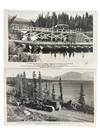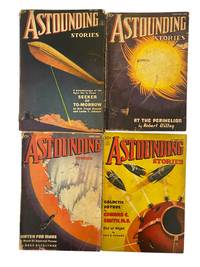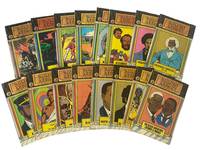by Alaska, Highway
Construction of the Alaska Highway and surrounding infrastructure photo archive. Includes 30 silver gelatin black-and-white photographs, ranging from original silver gelatin snapshots to captioned Public Roads Administration and War Information Board prints. Most photographs date from ca. 1942–1944, with earlier vernacular images (ca. 1920s-30s) showing frontier scenes. Sizes range from 5.5” x 3.5” to 2.5” x 1.5”.
A striking visual record of one of the most ambitious engineering feats of the 20th century, these images capture the terrain, labor, and logistics behind the construction of the Alaska Highway, a 1,700-mile overland military supply route connecting the contiguous U.S. to Alaska through Canada. Following Japan’s attack on Pearl Harbor and the invasion of the Aleutians, the highway was prioritized for national defense. The archive includes 21 official WPA and War Information Board photos captioned with patriotic language emphasizing the inter-allied labor of American GIs and Canadian workers. These include dramatic landscapes—“View along the new Alaska Highway through Canada’s wilderness”—and staged shots of vehicles amid pristine terrain: “Along the Alaska Highway through Canada’s wilderness...built by a welcome army of U.S. soldiers.” Machinery dominates several scenes: a heavy-duty grader “skirting a mountain lake,” or another “clearing the way...Canadian timber was a pushover for powerful tractors.” One image shows a man axing through permafrost in August—“chopping permanent ice uncovered...melting of such ice...was one of the problems solved.” Several prints depict pontoon bridges, early roadbeds, and scenic vistas, often with military jeeps or convoys posed against the wild.
Ten vernacular photos provide a broader portrait of Alaskan and Yukon life in the decades leading up to the war. These include couples in a sled, frontier couples posing with fish, and a Chinese barber giving another man a shave. A sizable Chinese population grew in Alaska, just like it did elsewhere in the West, as a result of a gold rush, in this case, likely the Yukon Gold Rush of 1896. Other snapshots show men cutting brush and operating heavy equipment—likely CCC or WPA crews from earlier territorial improvement efforts. Several are captioned in pencil on verso with Alaskan locations: “Juneau,” “Valdez,” and “Saw Mill”. Light curling and handling wear to vernacular prints; minor edge wear to WPA and War Board images, some with faint stamps or captions trimmed. Overall very good condition. A powerful photographic collection uniting federal propaganda and vernacular realism, offering a rare ground-level view of one of WWII’s most consequential domestic infrastructure projects. (Inventory #: 21815)
A striking visual record of one of the most ambitious engineering feats of the 20th century, these images capture the terrain, labor, and logistics behind the construction of the Alaska Highway, a 1,700-mile overland military supply route connecting the contiguous U.S. to Alaska through Canada. Following Japan’s attack on Pearl Harbor and the invasion of the Aleutians, the highway was prioritized for national defense. The archive includes 21 official WPA and War Information Board photos captioned with patriotic language emphasizing the inter-allied labor of American GIs and Canadian workers. These include dramatic landscapes—“View along the new Alaska Highway through Canada’s wilderness”—and staged shots of vehicles amid pristine terrain: “Along the Alaska Highway through Canada’s wilderness...built by a welcome army of U.S. soldiers.” Machinery dominates several scenes: a heavy-duty grader “skirting a mountain lake,” or another “clearing the way...Canadian timber was a pushover for powerful tractors.” One image shows a man axing through permafrost in August—“chopping permanent ice uncovered...melting of such ice...was one of the problems solved.” Several prints depict pontoon bridges, early roadbeds, and scenic vistas, often with military jeeps or convoys posed against the wild.
Ten vernacular photos provide a broader portrait of Alaskan and Yukon life in the decades leading up to the war. These include couples in a sled, frontier couples posing with fish, and a Chinese barber giving another man a shave. A sizable Chinese population grew in Alaska, just like it did elsewhere in the West, as a result of a gold rush, in this case, likely the Yukon Gold Rush of 1896. Other snapshots show men cutting brush and operating heavy equipment—likely CCC or WPA crews from earlier territorial improvement efforts. Several are captioned in pencil on verso with Alaskan locations: “Juneau,” “Valdez,” and “Saw Mill”. Light curling and handling wear to vernacular prints; minor edge wear to WPA and War Board images, some with faint stamps or captions trimmed. Overall very good condition. A powerful photographic collection uniting federal propaganda and vernacular realism, offering a rare ground-level view of one of WWII’s most consequential domestic infrastructure projects. (Inventory #: 21815)












